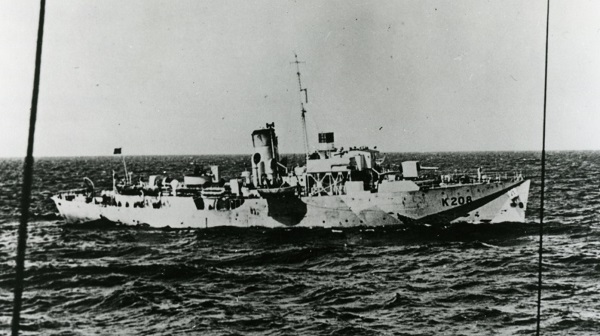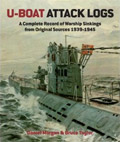Allied Warships
HNoMS Montbretia (K 208)
Corvette of the Flower class

Photo courtesy of Marinemuseet
| Navy | The Royal Norwegian Navy |
| Type | Corvette |
| Class | Flower |
| Pennant | K 208 |
| Built by | Fleming & Ferguson Ltd. (Paisley, Scotland) |
| Ordered | 28 Jun 1940 |
| Laid down | 16 Nov 1940 |
| Launched | 27 May 1941 |
| Commissioned | 29 Sep 1941 |
| Lost | 18 Nov 1942 |
| Loss position | 53° 37'N, 38° 15'W |
| History | At 0851 hours on 18 November 1942, HNoMS Montbretia (Lt.Cdr. Halvor Søiland) was hit in the starboard bow by one of three torpedoes fired from U-262, while she was investigating a radar contact. The corvette had already been missed earlier that night by a torpedo from U-624 at 0603 hours. The torpedo explosion opened a large hole in the bow, the forecastle deck twisted upwards and caused the ammunition of the 4in gun to explode, sending debris of the gun platform over the after deck killing three men. The roof of the Asdic deck came down, the bridge distorted and the bulkheads in the wheelhouse stowed in, killing the helmsman. The commander gave order to abandon ship and three carley floats were launched until a second torpedo struck on the port side in the boiler room, breaking the ship in two and caused the ship to sink rapidly in position 53º37'N, 38º15'W. First it was thought that the corvette was hit by two different U-boats, but U-262 had fired a single torpedo at 0857 hours on a second escort vessel (as Franke wrong assumed), apparently the corvette turned around after the first hit and was hit by the same U-boat. The HNoMS Potentilla picked up 20 survivors from two carley floats and five from a cork net. Some of them were badly injured and two later died and were buried at sea that same afternoon. 40 Norwegians and 8 British of the crew died. 8 of the survivors were wounded. Hit by U-boat |
| U-boat Attack | See our U-boat attack entry for the HNoMS Montbretia |
| Former name | HMS Montbretia |
Commands listed for HNoMS Montbretia (K 208)
Please note that we're still working on this section
and that we only list Commanding Officers for the duration of the Second World War.
| Commander | From | To | |
| 1 | Lt.Cdr. Halvor Søiland, RNON | ??? | 18 Nov 1942 |
You can help improve our commands section
Click here to Submit events/comments/updates for this vessel.
Please use this if you spot mistakes or want to improve this ships page.
Notable events involving Montbretia include:
6 Nov 1941
Convoy SL 92.
This convoy departed Freetown for the U.K. on 6 November 1941.
The convoy was made up of the following merchant vessels; Andreas (Greek, 6566 GRT, built 1919), Baron Herries (British, 4574 GRT, built 1940), Brika (British, 4412 GRT, built 1929), Calumet (British, 7268 GRT, built 1923), City of Worcester (British, 5469 GRT, built 1927), Clan MacWhirter (British, 5941 GRT, built 1918), Clan Ross (British, 5897 GRT, built 1914), Corabella (British, 5682 GRT, built 1937), Desirade (British, 9645 GRT, built 1921), Elmdale (British, 4872 GRT, built 1941), Empire Byron (British, 5894 GRT, built 1926), Euryades (British, 5801 GRT, built 1913), Gazcon (British, 4224 GRT, built 1932), Holmbury (British, 4566 GRT, built 1925), Imber (British, 1899 GRT, built 1920), Jeypore (British, 5318 GRT, built 1920), Lynhaug (Norwegian, 2829 GRT, built 1919), Maro (Greek, 3836 GRT, built 1924), Mary Slessor (British, 5027 GRT, built 1930), Meliskerk (Dutch, 6045 GRT, built 1919), Mokambo (British, 4996 GRT, built 1938), Nagpore (British, 5283 GRT, built 1920), New Brunswick (British, 6529 GRT, built 1919), Observer (British, 5881 GRT, built 1928), Penrose (British, 4393 GRT, built 1928), Pentridge Hill (British, 7579 GRT, built 1941), Richmond Hill (British, 7579 GRT, built 1940), Ripley (British, 4997 GRT, built 1936), San Francisco (Swedish, 4933 GRT, built 1915), Sandown Castle (British, 7607 GRT, built 1921), Savoia (British, 5490 GRT, built 1922), Skeldergate (British, 4251 GRT, built 1930), Sobo (British, 5353 GRT, built 1937), Tore Jarl (Norwegian, 1514 GRT, built 1920) and Zouave (British, 4256 GRT, built 1930).
The RFA tanker Rapidol (2648 GRT, built 1917) was also with the convoy to test the concept of an oiler for the escorts. She remained with the convoy until 12 November 1941.
On departure from Freetown the convoy was escorted by the destroyers HMS Vansittart (Lt.Cdr. R.L.S. Gaisford, RN), HMS Velox (Lt.Cdr. E.G. Roper, DSC, RN) and the corvettes HMS Burdock (T/Lt. H.J. Fellows, SANF(V)), HMS Marguerite (Lt.Cdr. A.N. Blundell, RNR) and HMS Starwort (Lt.Cdr. N.W. Duck, RD, RNR).
HMS Velox returned to Freetown on 12 November 1941, presumably she had parted company with the convoy on 10 November.
The heavy cruiser HMS Dorsetshire (Capt. A.W.S. Agar, VC, DSO, RN) and light cruiser HMS Dunedin (Capt. R.S. Lovatt, RN) provided close cover for the convoy during 12 and 13 November 1941.
On 11 November 1941 the sloop HMS Egret (A/Capt. E.M. Haes, RN) and cutters Banff (Lt.Cdr. P.S. Evans, RN) and Fishguard (Lt.Cdr. H.L. Pryse, RN) joined the convoy. They were then to fuel from the Rapidol but apparently only HMS Egret did so.
On 12 November 1941, HMS Vansittart,HMS Burdock, HMS Marguerite and HMS Starwort parted company to join convoy OS 10 coming from the U.K. taking the Rapidol.
On 24 November 1941, the destroyers HMS Foresight (Cdr. J.S.C. Salter, RN), HMS Fury (Lt.Cdr. T.C. Robinson, RN), escort destroyers HMS Badsworth (Lt.Cdr. M.S. Townsend, DSC and Bar, OBE, RN) and HMS Croome (Lt.Cdr. J.D. Hayes, DSO, RN) joined.
On 25 November 1941, the destroyer HMS Forester (Lt.Cdr. E.B. Tancock, DSC and Bar, RN) joined.
Later on 25 November 1941, HMS Foresight, HMS Forester, HMS Fury, escort destroyers HMS Badsworth and HMS Croome parted company with the convoy.
HMS Egret parted company with the convoy on 29 November 1941.
On 30 November 1941, the corvette HNoMS Montbretia and A/S trawler HMS Man o' War (T/Lt. W.W. Creber, RNR) joined the convoy but parted company again later the same day.
A/S trawler HMS Arab (T/Lt. C.A. Shillan, RNVR) was with the convoy on 1 December.
The convoy arrived in U.K. waters on 1 December 1941.
15 Aug 1942
HMS H 43 (Lt. J.C.Y. Roxburgh, DSC, RN) conducted A/S exercises off Lough Foyle with HNoMS Montbretia and HNoMS Potentilla. (1)
30 Aug 1942
Convoy HX 205.
This convoy departed Halifax on 30 August 1942.
On departure from Halifax the convoy was made up of the following merchant vessels; Alcoa Master (American, 5114 GRT, built 1919), Alcoa Rambler (American, 5500 GRT, built 1919), Antilochus (British, 9082 GRT, built 1906), Audacious (Panamanian, 7166 GRT, built 1913), Beaverhill (British, 10041 GRT, built 1928), Bello (Norwegian (tanker), 6125 GRT, built 1930), Brilliant (American (tanker), 9132 GRT, built 1930), Brimanger (Norwegian, 4883 GRT, built 1929), British Character (British (tanker), 8453 GRT, built 1941), British Glory (British (tanker), 6995 GRT, built 1928), Cefalu (Honduran, 5221 GRT, built 1930), City of Bombay (British, 7140 GRT, built 1937), Clan MacPherson (British, 6940 GRT, built 1929), Emma Bakke (Norwegian, 4721 GRT, built 1929), Empire Airman (British (tanker), 9813 GRT, built 1942), Empire Emerald (British (tanker), 8032 GRT, built 1941), Empire Gold (British (tanker), 8028 GRT, built 1941), Empire Kamal (British, 7862 GRT, built 1938), Exchester (American, 4999 GRT, built 1919), Ferncourt (British (tanker), 9918 GRT, built 1938), Fort Amherst (British, 3489 GRT, built 1936), Gdynia (Swedish, 1636 GRT, built 1934), Grey County (Norwegian, 5194 GRT, built 1918), Hoegh Scout (Norwegian (tanker), 9924 GRT, built 1939), James J. Maguire (British (tanker), 10525 GRT, built 1939), Katy (Norwegian (tanker), 6825 GRT, built 1931), Kosmos II (Norwegian (whale factory ship serving as tanker), 16966 GRT, built 1931), Lady Rodney (Canadian, 8194 GRT, built 1929), Lancastrian Prince (British, 1914 GRT, built 1940), Luminetta (British (tanker), 6159 GRT, built 1927), Lynghaug (Norwegian, 2829 GRT, built 1919), Magdala (Dutch (tanker), 8248 GRT, built 1931), Mark Twain (American, 7176 GRT, built 1942), Minerva (Norwegian, 5883 GRT, built 1930), Molda (Norwegian, 5137 GRT, built 1937), Nicania (British (tanker), 8179 GRT, built 1942)), Norheim (Norwegian (tanker), 9816 GRT, built 1941), Nortun (Panamanian, 3663 GRT, built 1940), Ocean Rider (British, 7178 GRT, built 1942), Ocean Verity (British, 7174 GRT, built 1942), Pacific Grove (British, 7117 GRT, built 1928), Port Alma (British, 8400 GRT, built 1928), Rapana (British (tanker), 8017 GRT, built 1935), Reverdy Johnson (American, 7191 GRT, built 1942), Richard Henry Lee (American, 7191 GRT, built 1941), Robin Goodfellow (American, 6885 GRT, built 1920), Saint Bertrand (British, 5522 GRT, built 1929), Sandanger (Norwegian (tanker), 9432 GRT, built 1938), Thorshov (Norwegian (tanker), 9955 GRT, built 1935), Thorshovdi (Norwegian (tanker), 9944 GRT, built 1937), Turrialba (British, 4961 GRT, built 1909), Ulysses (Dutch, 2655 GRT, built 1918), Walt Whitman (American, 7176 GRT, built 1942), Waroonga (British, 11243 GRT, built 1914), Westland (Dutch, 5888 GRT, built 1931), William Wirt (American, 7191 GRT, built 1942), Zacapa (American, 5013 GRT, built 1909) and Zebulon B. Vance (American, 7176 GRT, built 1942).
The escort carrier (in an aircraft ferry role), HMS Dasher (Cdr. C.N. Lentaigne, DSO, RN) and the rescue ship Melrose Abbey (British, 1924 GRT, built 1929) were also part of the convoy.
On departure from Halifax the convoy was escorted by the destroyers HMS Vanoc (A/Cdr. C.F.H. Churchill, RN), HMS Buxton (Lt.Cdr. I.J. Tyson, RD, RNR) and the corvettes HMCS Camrose (T/Lt L.R. Pavillard, RCNVR), HMCS Midland (T/Lt. A.B. Taylor, RCNR) and HMCS Sorel (T/Lt. M.H. Wallace, RCNR).
Around 0930Z/2, the destroyer HMS Viscount (Lt.Cdr. J.V. Waterhouse, RN) and corvette HNoMS Potentilla joined in position 46°23'N, 51°37'W. HMS Vanoc and HMS Buxton then parted company.
Around 1100Z/2, the corvettes HNoMS Acanthus, HNoMS Eglantine, HNoMS Montbretia and HMS Borage (T/Lt.Cdr. A. Harrison, RNR) joined the convoy in position 46°33'N, 51°24'W. HMCS Camrose, HMCS Midland and HMCS Sorel then parted company.
Also on 2 September the Fort Amherst and Lady Rodney left the convoy for St. Johns, Newfoundland.
Around 1310Z/2, HMS Viscount left the convoy due to a machinery defect having developed. She returned to St. Johns, Newfoundland to effect repairs.
Around 1940Z/2, the destroyer HMS Broke (Lt.Cdr. A.F.C. Layard, RN) joined as temporary replacement of HMS Viscount.
Around 2000Z/4, HMS Viscount rejoined the convoy in position 50°27'N, 39°41'W. HMS Broke then parted company.
Around 2000Z/8, in position 56°17'N, 18°17'W, the merchant vessel Beaverhill was detached. She took HMS Borage with her as escort. The corvette was to escort her until 07°00'W after which she was to proceed to Londonderry.
Around 0300Z/10, HMS Dasher parted company to proceed independently to the Clyde.
Around 0530Z/10, the Loch Ewe portion of the convoy was detached to proceed there unescorted. At the same time HNoMS Potentilla was detached to proceed to Greenock.
The main portion of the convoy arrived in U.K. water later on the 10th. (2)
19 Sep 1942
HMS H 32 (Lt. J.R. Drummond, RN) conducted A/S exercises off Lough Foyle with HNoMS Montbretia and HNoMS Potentilla. (3)
Media links
|
Sources
- ADM 173/17252
- ADM 199/717 + ADM 199/2100
- ADM 173/17217
ADM numbers indicate documents at the British National Archives at Kew, London.
As an Amazon Associate uboat.net earns a commission from qualifying purchases.


